This article was published in Scientific American’s former blog network and reflects the views of the author, not necessarily those of Scientific American
What is Plica plica? It’s a strikingly proportioned, diurnal, arboreal iguanian lizard that can exceed 17 cm in total length, and has a range that encompasses a huge part of northern South America (on which… read on). Indeed, Etheridge (1970) described Plica plica and its close relative P. umbra as “among the most abundant, widespread, and earliest known lizards of South America” (p. 237). That “earliest known” always looks odd: what he meant is that P. plica is among the earliest of South American lizards to be scientifically recognised, since Linnaeus listed it (as ‘Lacerta Plica’) in 1758.
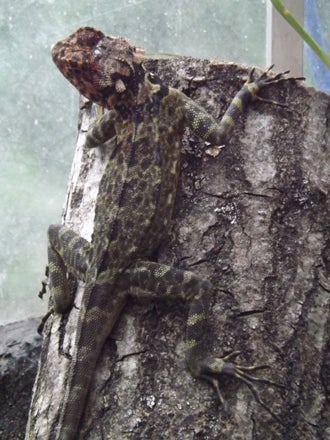
Captive Plica, labelled as P. plica (but is it? Read on). Credit: Darren Naish
I say that this lizard is “strikingly proportioned” because it’s shockingly suited for arboreal, trunk-clinging life, being highly gracile – almost spidery – and with a very slim tail, slender digits and hooked claws.
On supporting science journalism
If you're enjoying this article, consider supporting our award-winning journalism by subscribing. By purchasing a subscription you are helping to ensure the future of impactful stories about the discoveries and ideas shaping our world today.
Plica is a tropidurine, a group of iguanian lizards that I thought I’d written about before. On checking, it turns out that I’ve written (more than once) about the liolaemines, another iguanian group sometimes confused or combined with tropidurines but nowadays thought to be quite distinct from them (Pyron et al. 2013). Indeed, a taxonomic system that recognises these major lizard groups as ‘families’ and separate from the super-inclusive Iguanidae of tradition probably best reflects their distinct nature, and phylogenetic history. Tropidurines (Tropiduridae, if we go with that family-level thing) actually seem to be the sister-group to all other pleurodont iguanians so they’ve almost definitely been distinct since early in the Cenozoic if not before (Townsend et al. 2011). In addition to Plica, Tropiduridae includes Eurolophosaurus, Microlophus, Stenocercus, Strobilurus, Tropidurus, Uracentron and Uranoscodon.
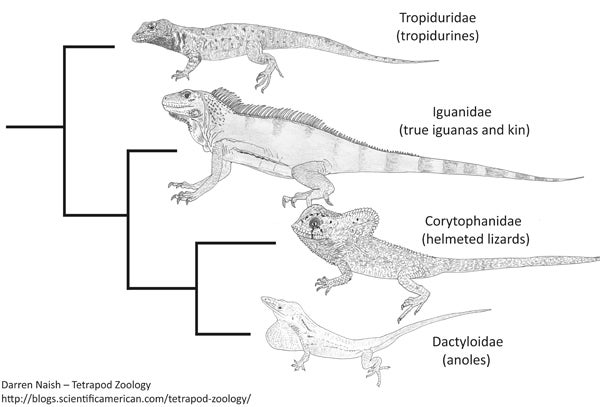
Much simplified, stripped-down cladogram for pleurodont iguanians -- more complete, more complex versions of this tree will appear here in later articles. It’s one of the hundreds of illustrations produced for my in-prep textbook on the vertebrate fossil record on which go here. Credit: Darren Naish
Anyway, those arboreal habits explain why the Plica species are sometimes called ‘tree runners’, though – frankly – this is a terrible name since it could refer to just about anything. The names Collared tree lizard, Collared tree runner and Harlequin racerunner are apparently also in use for P. plica. Calling it a ‘racerunner’ also seems less than brilliant given that the term ‘racerunner’ is more normally applied to a group of teiids. Thanks to Wikipedia, I know that a local name used for P. plica in Guyana is wakanama, and I so wish that this was in general use as its vernacular name.
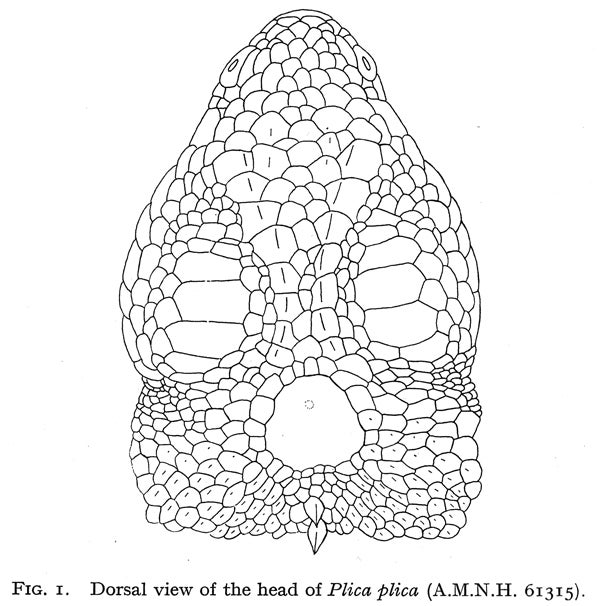
The head of a P. plica specimen in dorsal view, showing scalation. Squamates vary in how symmetrical their head scales are, and minor asymmetry (as seen here) is common in many species. Credit: Etheridge 1970
Finally, an interesting thing about P. plica (of tradition) is that it’s highly variable across its range, in size, the shape of the snout, the size and nature of the scales and neck spines, and in how much spotting there is on the throat. Etheridge (1970) drew attention to this variation but noted that the poor preservation of many of the specimens used in his study did not allow this variation to be analysed more carefully. And it has long seemed plausible that various subspecies or even species might be involved.
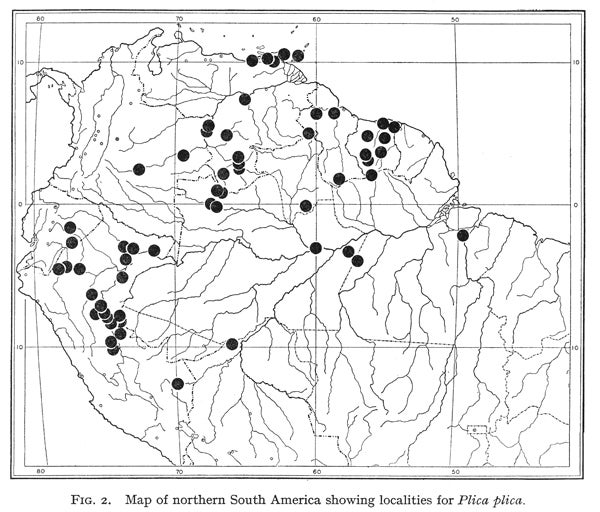
A map from Etheridge’s 1970 study of P. plica, showing the reported localities he was aware of. As you can see, this species - as perceived by Etheridge - was meant to have an enormous range, and to occur across a fairly wide range of topographies and habitats. Credit: Etheridge 1970
And… sure enough, Murphy & Jowers (2013) used both morphological and molecular data to show, quite convincingly, that P. plica of tradition is indeed a complex of cryptic species: they named a bunch of new species, namely the Caribbean treerunner P. caribeana [not a typo] of the Eastern Coastal Range of Venezuela, Trinidad and Tobago, Kathleen’s treerunner P. kathleenae of Guyana, Medem’s treerunner P. medemi of Colombia, and Ray’s treerunner P. rayi of Venezuela and Colombia. P. plica proper is restricted to Surinam. Furthermore, this isn’t the end of it, since they noted that their study was not a revision of the entire species complex but merely an initial demonstration of ‘P. plica’s’ polytypic status. In another Plica-based study, Paula de Oliveira et al. (2016) found another species – P. umbra – to also be a species complex. A key point they made in that study is that: “If the observed diversity of lineages within the genus Plica is characteristic of squamate reptiles of the Amazon region, the diversity of squamates is grossly underestimated”. A non-trivial observation.
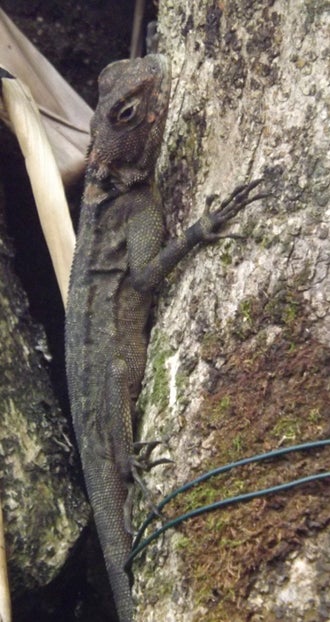
Another captive Plica specimen, labelled as P. plica (but does it really belong to that species in the strict sense?). These lizards are most typically seen clinging vertically as in the photos here. Credit: Darren Naish
All of this leaves me wondering as goes the precise status of the captive animals – labelled P. plica – shown in the photos here. The reddish head makes the animal featured at the top of the article look like one photographed in the Sierra de Lema of Venezuela, and figured by Murphy & Jowers (2013), though I can’t work out from their paper which species that specific specimen belongs to. Ho hum.
Iguanians might be over-represented (as lizards go) at Tet Zoo, in part because they’re kept more frequently in captivity than other lizard groups and hence are more likely to be photographed. One thing I aim to deal with when time allows: that whole Toxicofera thing! For previous Tet Zoo articles on iguanians, see...
Harduns and toad-heads; a tale of arenicoly and over-looked convergence
The Squamozoic actually happened (kind of): giant herbivorous lizards in the Paleogene
Australia, land of dragons (by which I mean: agamids) (part I)
By the Horns of Trioceros, the Casque of Calumma, the Brood of Bradypodion--Chameleons, Part 2
Palleon, Archaius, Kinyongia, Nadzikambia--The Last Chameleons, Part 3
Refs - -
Etheridge, R. 1970. A review of the South American iguanid lizard genus Plica. Bulletin of the British Museum (Natural History) 19, 237-256.
Murphy, J. C. & Jowers, M. J. 2013. Treerunners, cryptic lizards of the Plica plica group (Squamata, Sauria, Tropiduridae) of northern South America. Zookeys 355, 49-77.
Paula de Oliveira, D., Tadeu de Carvalho, V. & Hrbek, T. 2016. Cryptic diversity in the lizard genus Plica (Squamata): phylogenetic diversity and Amazonian biogeography. Zoologica Scripta 45, 630-641.
Townsend, T. M., Mulcahy, D. G., Noonan, B. P., Sites, J. W., Kuczynski, C. A., Wiens, J. J. & Reeder, T. W. 2011. Phylogeny of iguanian lizards inferred from 29 nuclear loci, and a comparison of concatenated and species-tree approaches for an ancient, rapid radiation. Molecular Phylogenetics and Evolution 61, 363-380.